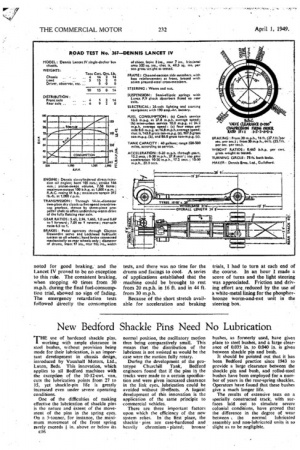New Bedford Shackle Pins Need No Lubrication
Page 22

If you've noticed an error in this article please click here to report it so we can fix it.
THE use of hardened shackle pins, working with ample clearance in steel bushes, without provision being made for their lubrication, is an important development in chassis design, introduced by Vauxhall Motors, Ltd., Luton, Beds. This innovation, which applies to all Bedford machines with the exception of the 10-12-cwt. van, cuts the lubrication points from 27 to 15, yet shackle-pin life is greatly increased even under severe operating conditions.
One of the difficulties of making effective the lubrication of shackle pins is the nature and extent of the movement of the pins in the spring eyes. On a 5-tonner, for instance, the maximum movement of the front spring rarely exceeds in. above or below its cl 6 normal position, the oscillatory motion thus being comparatively small. This means that the distribution of the lubricant is not assisted as would be the case were the motion fully rotary.
During the development of the prototype Churchill Tank, Bedford engineers found that if the pins in the tracks were made to a certain specification and were given increased clearance in the link eyes, lubrication could be avoided without ill-effects. A logical development of this innovation is the application of the same principle to commercial vehicles.
There are three important factors upon which the efficiency of the new system relies. In the first place, the shackle pins are case-hardened and heavily chromium plated; bronze bushes, as formerly used, have given place to steel bushes, and a large clearance of 0.035 in. to 0.040 in. is given between shackle pin and bush.
It should be pointed out that it has been Bedford practice since 1943 to provide a large clearance between the shackle pin and bush, and rolled-steel bushes have been employed for a number of years in the rear-spring shackles. Operators have found that these bushes give a much longer life.
The results of extensive tests on a specially constructed track, with surfaces laid out to simulate severe colonial conditions, have proved that the difference in the degree of wear between ■ the normal lubricated assembly and non-lubricated units is so slight as to be negligible,


























